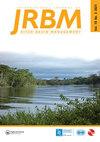Drainage area is not enough: multivariate hydraulic geometry in the Southern Blue Ridge Mountains, USA
IF 1.9
Q3 WATER RESOURCES
International Journal of River Basin Management
Pub Date : 2023-10-23
DOI:10.1080/15715124.2023.2274463
引用次数: 0
Abstract
AbstractRegional hydraulic geometry curves, which relate drainage area to channel morphology, are powerful tools for river restoration and watershed management. While there is a strong correlation between channel morphology and drainage area, the importance of watershed slope and relief on channel-forming flow, especially in mountainous regions, cannot be ignored. This research used single variable power functions along with multiple regression to determine which network- and or local-scale variables are influencing channel morphology in the Southern Blue Ridge Mountains. Within this region, watershed topography (i.e., relief and slope) and or local-scale characteristics (e.g., channel slope and sinuosity) are better predictors of channel morphology than drainage area. Additionally, the importance of local-scale characteristics in the multiple regression models provide strong evidence that site-specific conditions can be just as important as watershed characteristics in determining channel morphology. While multiple regression has been used to create hydraulic geometry equations in other regions, this is the first study that determined whether non-drainage area multiple regression models perform better than models that include drainage area. With the increasing ease with which network- and local-scale characteristics can be calculated, this research shows a clear need to incorporate additional network- and or site-specific characteristics into hydraulic geometry equations.Keywords: hydraulic geometrymultiple regressionfluvial geomorphologywatershedlocal-scaleGISDisclaimerAs a service to authors and researchers we are providing this version of an accepted manuscript (AM). Copyediting, typesetting, and review of the resulting proofs will be undertaken on this manuscript before final publication of the Version of Record (VoR). During production and pre-press, errors may be discovered which could affect the content, and all legal disclaimers that apply to the journal relate to these versions also. 7. DISCLOSURE STATEMENTThe authors report there are no competing interests to declare.流域面积不够:美国蓝岭山脉南部的多元水力几何
区域水力几何曲线是流域面积与河道形态之间的联系,是河道修复和流域管理的有力工具。虽然河道形态与流域面积之间存在很强的相关性,但流域坡度和地形对河道形成流的重要性不容忽视,尤其是在山区。本研究使用单变量幂函数以及多元回归来确定哪些网络和/或局部尺度变量正在影响南蓝岭山脉的河道形态。在该区域内,流域地形(如地形起伏和坡度)和(或)局地尺度特征(如河道坡度和弯曲度)比流域面积更能预测河道形态。此外,多元回归模型中局部尺度特征的重要性提供了强有力的证据,表明在决定河道形态方面,特定地点的条件与流域特征一样重要。虽然多元回归已经在其他地区用于创建水力几何方程,但这是第一次确定非排水区域多元回归模型是否优于包括排水区域的模型。随着网络和局部尺度特征的计算越来越容易,这项研究表明,有必要将额外的网络和/或场地特定特征纳入水力几何方程。关键词:水力几何多元回归河流地貌分水岭局域尺度gis免责声明作为对作者和研究人员的服务,我们提供此版本的接受稿件(AM)。在最终出版版本记录(VoR)之前,将对该手稿进行编辑、排版和审查。在制作和印前,可能会发现可能影响内容的错误,所有适用于期刊的法律免责声明也与这些版本有关。7. 声明作者报告无利益竞争需要申报。
本文章由计算机程序翻译,如有差异,请以英文原文为准。
求助全文
约1分钟内获得全文
求助全文
来源期刊

International Journal of River Basin Management
WATER RESOURCES-
CiteScore
6.00
自引率
4.00%
发文量
48
期刊介绍:
include, but are not limited to new developments or applications in the following areas: AREAS OF INTEREST - integrated water resources management - watershed land use planning and management - spatial planning and management of floodplains - flood forecasting and flood risk management - drought forecasting and drought management - floodplain, river and estuarine restoration - climate change impact prediction and planning of remedial measures - management of mountain rivers - water quality management including non point source pollution - operation strategies for engineered river systems - maintenance strategies for river systems and for structures - project-affected-people and stakeholder participation - conservation of natural and cultural heritage
 求助内容:
求助内容: 应助结果提醒方式:
应助结果提醒方式:


